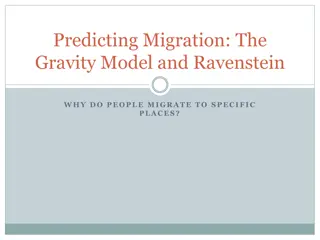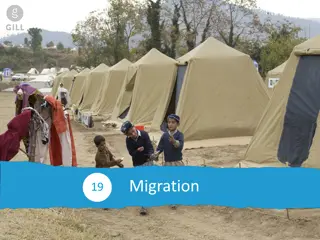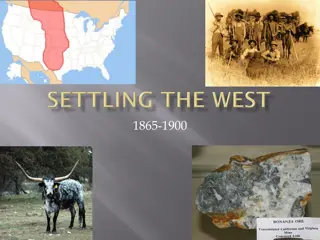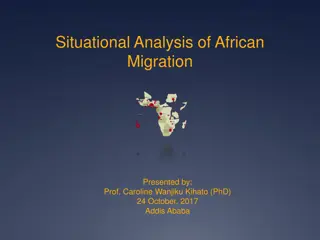American West Migration and Settlement Overview
Migration and settlement in the American West were driven by Manifest Destiny, push and pull factors, such as the Oregon Trail, Gold Rush, Homestead Act, and Indian Wars. The journey was perilous yet successful, with challenges like lawlessness in mining towns, conflicts between ranchers and homesteaders, and government policies impacting Native American tribes.
Download Presentation

Please find below an Image/Link to download the presentation.
The content on the website is provided AS IS for your information and personal use only. It may not be sold, licensed, or shared on other websites without obtaining consent from the author. Download presentation by click this link. If you encounter any issues during the download, it is possible that the publisher has removed the file from their server.
E N D
Presentation Transcript
American West Revision Thematic
Migration and Settlement Manifest Destiny God s will Push and Pull factors to move WEST Oregon Trail 5000Km. 5 months, mountains, dangerous. Wagon trains. Donner Party disaster new trail, split up, snow in mountains. Cannibals. Mormons to Salt Lake City. Successful migration. Planning, advanced party. Gold Rush (49ers) San Francisco gangs Early problems of farming. Civil War Homestead Act 1862- 160 acres, $10 plot Pacific Railroad Act 1862 Built from both ends. Sold land along the track. Transcontinental Railway. +ve settlers, farmers. ve for Indians. Homesteaders solved farming problems. Timber Culture Act 1873 Exoduster Movement 1879 (Freed black slaves from S to Kansas) Oklahoma Land Rush- midday charge for plots of land. Whites took last Indian land in reservations. Lawlessness Plains Indians Mining Towns The Gold Rush mining towns problems with law and order. Absence of women, isolated, alcohol, gangs, gambling, prostitution, racism of Chinese, new crimes e.g. claim jumping. Attempts to tackle crime sheriff, marshals, vigilantes. Problems slow to respond, poorly paid, corrupt law enforcement. Civil War young men traumatised and economy damaged led to crime. Cow towns and Railways Hell on Wheels railroad cow towns such as Abilene. Pinkerton detective Agency Ranches and mining Billy the Kid Range Wars e.g Johnson County War Wyatt Earp corrupt law enforcement? Traditional way of life Tribes / bands/ warrior societies. Nomadic, Tipis Horses and Buffalo Scalping Counting Coup Spirits and sacred land Impact of White Settlement Oregon Trail Gold Rush Railroads Cattle Industry Homestead Act Changing government attitude Reservations Extermination of the Buffalo Dawes Act End of the Indian Frontier 1890. Farming and Ranching Problems farming in the Plains climate, lack of water, natural hazards, lack of wood etc. Solutions to the problems Dry farming, Turkey Red wheat, wind pumps, new ploughs, barbed wire, sod houses Civil War N Vs S over slavery. N won. Quarantines stopped cattle drives East Cattle Drives and cowboys Goodnight Loving Trail WEST 1866 McCoy- Chisolm Trail to Abilene and trains EAST 1867 Iliff cattle ranch in Colorado, start of the Open Range 1870 Timber Culture Act 1873 gave Homesteaders another 160 acres of land if they promised to plant trees on 1/2 of it. Changing role of cowboys from cattle drives to ranches on the open range and then to small ranches. Ranches Vs homesteaders (Range wars, barbed wire) New technology for farmers Overgrazing and overstocking of cattle on the Open Range Winter 1886-87 The Great Die Up. Loads of cattle died and ranches went bankrupt. Smaller ranches End of the Open Range. Indian Wars 1862. Little Crow s War. Indians starving on reservations. Fought back. 1864. Sand Creek Massacre Cheyenne killed in their camp after attacking wagon trains. White flag. 1866. Red Cloud s War. Gold found in Black Hills. Indians attacked miners crossing their land on Bozeman Trail. Indians won. Led to 2nd FL Treaty. 1876. Battle of Little Big Horn the Sioux beat and killed General George Custer. (part of Great Sioux Wars) 1890.. Wounded Knee 250 Indians killed when doing the Ghost dance. Government Laws 1830. Indian Removal Act - Moved from East to the Great Plains 1834. Indian Trade and Intercourse Act permanent Indian Frontier set up 1851. Indian Appropriation Act- set up reservations to civilise the Indians, as whites wanted more land. 1851. Fort Laramie Treaty to solve conflict between whites on the Oregon Trail and Indians 1868. President Grant s Peace Policy Improve reservations, but Indians seen as hostile if didn t go. 1868. 2nd Fort Laramie Treaty Closed Boseman Trail and Sioux move to the Great Sioux Reservation. 1871. Indian Appropriation Act No longer treat Indians as separate nations . 1887. Dawes Act- Divide up reservations into 160 acre plots for Indian families. Livid Sioux Retaliated Back (at) Whites.
Indian Wars Event Individuals 1861-62- Little Crows War Little Crow 1862. Little Crow s War. Indians starving on reservations. Fought back. 1864-67. Cheyenne Wars and Sand Creek Massacre Cheyenne killed in their camp after attacking wagon trains. White flag. 1866. Red Cloud s War. Gold found in Black Hills. Indians attacked miners crossing their land on Bozeman Trail. Indians won. Led to 2nd FL Treaty. 1876. Battle of Little Big Horn the Sioux beat and killed General George Custer. (part of Great Sioux Wars) 1890.. Wounded Knee 250 Indians killed when doing the Ghost dance. 1864- Sand Creek Massacre Black Kettle Colonel Chivington 1866-68- Red Cloud s War Red Cloud Sitting Bull Crazy Horse 1876- Battle of Little Bighorn General Sheridan Lieutenant Colonel Custer Sitting Bull Crazy Horse Livid Sioux Retaliated Back (at) Whites. 1890- Ghost Dance and the Wounded Knee massacre Sitting Bull Big Foot Band
1862. Little Crows War. Indians starving on reservations. Fought back. Summarise the causes in 3 sentences Causes Little Crow was the leader of around 12,000 Santee Sioux who were moved onto a reservation, promised $1.4 million and an annuity of $80,000 for 24 million acres of land. However until the tribe paid debts owed to traders of $200,000 the government sent them no money. In 1858 they had to give away half the reservation to pay these debts. Due to pests devastating their crops, agents charging huge amounts for food and a delay in the payments, by August 1862 the tribe were starving. Narrative At first Little Crow tried to restrain his people but young warriors (called Dog Soldiers) believed they needed to take their land back to feed the people. So they attacked government warehouses, taking food and burning the buildings, killing over 700 settlers, agency workers and the soldiers sent to deal with them. But the victory was only temporary. Consequences By October the war was over. White settlers wanted the Sioux punished 400 were put on trial, they were sentenced to death with no evidence of their guilt. Only 38 were executed after Lincoln intervened. The 2000 Sioux left were punished by being moved to a smaller, barren reservation with no clean water. Nearly 400 died in the first winter. Chief Sitting Bull visited during this time of hardship and the situation he found there affected his attitude to the white settlers and authorities. Summarise the Narrative in 3 sentences Summarise the consequences in 3 sentences
1864-67 . Cheyenne War and Sand Creek Massacre Cheyenne killed in their camp after attacking wagon trains. White flag. Causes War on the Southern Plains was sparked by the discovery of gold at Pikes Peak in Colorado in 1859. The thousands of miners who travelled west demanded that the government do something about the Arapaho, Cheyenne and Kiowa. Under the Fort Laramie Treaty the area had been set up as their hunting ground, white Americans were allowed to cross but not settle. The Indians saw the mining settlement as breaking the treaty and were worried about the impact on the buffalo. Narrative The government tried to negotiate by giving the tribes a smaller reservation without a hunting ground. A Cheyenne chief Black Kettle signed the treaty but not all of the tribes accepted the terms and fighting broke out. On 29 November 1864 a force of 1000 men led by Colonel John M. Chivington attacked a Cheyenne village at Sand Creek. Black Kettle was flying a white flag as he thought the peace was in effect, Chivington did not. The US soldiers killed over 150 men, women and children and mutilated their bodies. Some white Americans treated Chivington as a hero, but others called it the foulest and most unjustifiable crime in the annals of America . The other Plains Indians attacked settlements across Kansas in retaliation. Consequences The Medicine Lodge Treaty 1867 the Arapaho, Cheyenne and Kiowa were given a choice to move onto a new reservation in Indian Territory (now Oklahoma) or be treated as hostile. Most chiefs signed and many moved. Battle of Washita 1868 Black Kettle and a group who did not agree to the treaty were defeated by the seventh Cavalry, led by George Custer. Violence carried on, with Indians attacking people who were killing the buffalo, but ended when the army started using rifles with telescopic lenses. Why are the following dates important? 1859 1864 1867 1868
1866 Red Clouds War Why are the following dates important? Causes The discovery of gold in 1862 Montana led to the Bozeman trail being set up, so that miners could reach the gold fields. Unfortunately this new trail broke the 1851 Fort Laramie Treaty, as it crossed the Lakota Sioux hunting lands. Narrative Red Cloud, chief of the Lakota Sioux, attacked the wagon trains. The government tried to solve the problem by offering gifts and opening peace talks, but Red Cloud broke off the talks when he found out that the government had already ordered forts to be built on the trail. Red Cloud and other Sioux leaders, Sitting Bull and Crazy Horse adapted the soldiers tactics and fought through the winter. They stopped people using the Bozeman Trail and laid siege to the forts, trapping and killing an army detachment led by a Captain William Fetterman (this became known as Fetterman s Massacre). Consequences The Indians could not capture the forts but no soldiers or travellers could use the Bozeman trail. So eventually the US government had to negotiate a new settlement. The new 1868 Fort Laramie Treaty agreed to close the Bozeman trail (they had found another route anyway) and the Great Sioux reservation was created. However Chief Sitting Bull and Crazy Horse did not sign the treaty, or live on the reservation. 1851 1862 Why did the government make this war worse? Why was Red Cloud s War negative for the Sioux?
1876. Battle of Little Big Horn the Sioux beat and killed General George Custer. (part of Great Sioux Wars) CAUSES Why were the Black Hills so important to the Sioux? The US government sent railroad inspectors and surveyors under General Custer into the Black Hills, a land sacred to the Sioux. Custer began to mine for gold in the Black Hills This broke the terms of the Fort Laramie Treaty signed 6 years earlier. They found gold in the hills. 1000 s of people flooded to the Black Hills to find Gold. The government could not prevent this. Leading to the Sioux Nation fighting back. Why did Custer break the Second Fort Laramie Treaty? 1) The government offered to buy the Black Hills for 6million or $40,000 a year for the mineral rights. The Sioux declined So the government under the leadership of Ulysses Grant gave the Indians 60 days to return to their reservation or they would be considered hostile and would be attacked. Bad weather prevented the Indians from obeying. Deep snow made it impossible to get back By the spring of 1876 more than 7,000 Indians, 2,000 of whom were warriors had put up 1,000 lodges on lands between the Powder river and the Rosebud river. They were ready for war 2) 3) What ultimatum did the government give the Indians? Why could they not do it? 4) 5)
1876. Battle of Little Big Horn the Sioux beat and killed General George Custer. (part of Great Sioux Wars) - NARRATIVE What were the problems with the armies plans? The plan was to attack the Sioux to force them back into reservations. General Sheridans plan was to have 3 columns of soldiers to trap the Indians between them: General Crook with 1049 cavalry northwards from Fort Fetterman; Colonel Gibbon with 450 infantry eastwards from Fort Shaw; General Terry with 1000 cavalry and Gatling (machine) guns westwards from Fort Abraham Lincoln. What mistake did Custer make? HOWEVER, THERE WERE POTENTIAL PROBLEMS 1. Generals Terry and Crook couldn t easily communicate 2. They wrongly assumed there would be about 800 Indians, based on BIA estimates (Bureau of Indian Affairs). 3. The Indians were better armed, with Winchester repeating rifles whereas the cavalrymen had single shot rifles. 4. The Indians knew the terrain. Why was the narrative of this event so significant? What would the government now do in response? CUSTER FOUND A CAMP OF 2,000 WARRIORS IN THE VALLEY OF THE LITTLE BIGHORN. CUSTER RECKLESSLY LED 200 OF HIS MEN INTO THE VALLEY. SITTING BULL GOT THE WOMEN AND CHILDREN TO SAFETY AND CRAZY HORSE LED AN ATTACK. CUSTOMER AND ALL 200 MEN WERE KILLED THE INDIANS WON
1876. Battle of Little Big Horn the Sioux beat and killed General George Custer. (part of Great Sioux Wars) - CONSEQUENCES Give 3 reasons why smaller reservations destroy the Indian way of life? PUBLIC PERCEPTIONS OF THE INDIANS CHANGED PEOPLE SAID THAT INDIANS HAD TO NOW BECOME AN AMERICAN CITIZEN OR DIE FOR WHITE SETTLERS TO ACHIEVE MANIFEST DESTINY. THE GOVERNMENT TOOK THE FOLLOWING STEPS 1. Plains Indians must be kept on their reservations By 1881, all Sioux were confined into a reservation COMPLETELY DEPENDENT ON THE US FOR FOOD. 2. All previous treaties could be ignored The government decided that Indians had no right to have treaty deals. These Plains Indians were moved onto smaller reservation in worse conditions. Sioux were forced to give up the Black Hills as the government threatened to give up their food. 3. Sioux had to give up all their weapons and horses and live under military rule. Number of soldiers increased. Why did the Indians have to give up the Black Hills? What did the American public now think of the Indians after Battle of Little Bighorn? IN SPRING OF 1877, CRAZY HORSE WAS KILLED ALL RESISTANCE TO LOSS OF LAND WAS OVER
1890 - . Wounded Knee 250 Indians killed when doing the Ghost dance. Causes By 1890, Indians on reservations were facing cuts in their rations, crop failures due to drought and despair at the loss of their lands and way of life. One response was the Ghost Dance. An Indian had a vision that if they all kept dancing, the Great Spirit would bring back the dead and a great flood would carry white people away. More and more Indians started dancing, this worried white settlers and the Army moved in to stop them. Sitting Bull was killed. Narrative Sitting Bulls followers fled south to join the band of Big Foot, who had also fled when the army moved in. 29th December 1890. Snow and pneumonia slowed Big Foot's band down and the army caught them. They were taken to Wounded Knee Creek where the army began to disarm them. The Indians started dancing and shooting broke out. Within 10 minutes 250 Indians (men, women and children) and 25 soldiers were dead. IT WAS THE END OF INDIAN RESISTANCE Consequences Public responded positively, the settlers were relieved the dance was stopped. Was seen as revenge for the defeat in the Battle of the Little Bighorn. Showed the fear that whites had against the Indians. Historians believe the Ghost Dance was based on millenarian beliefs. A supernatural event that will put all the wrongs right. By 1890 the government ended the Indian Frontier. Indian land was no more. What was the belief of the Ghost dance? Why could the Wounded Knee Massacre be seen as revenge for Battle of Little Bighorn? What did the government do by 1890 ? What did this mean?























